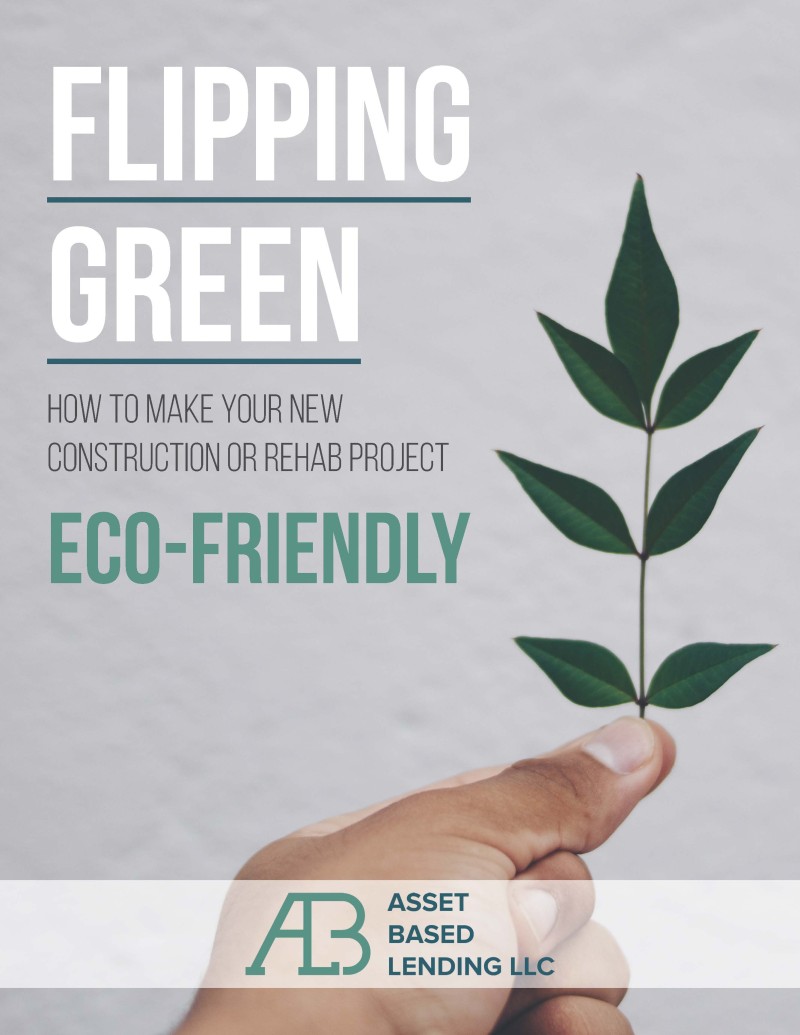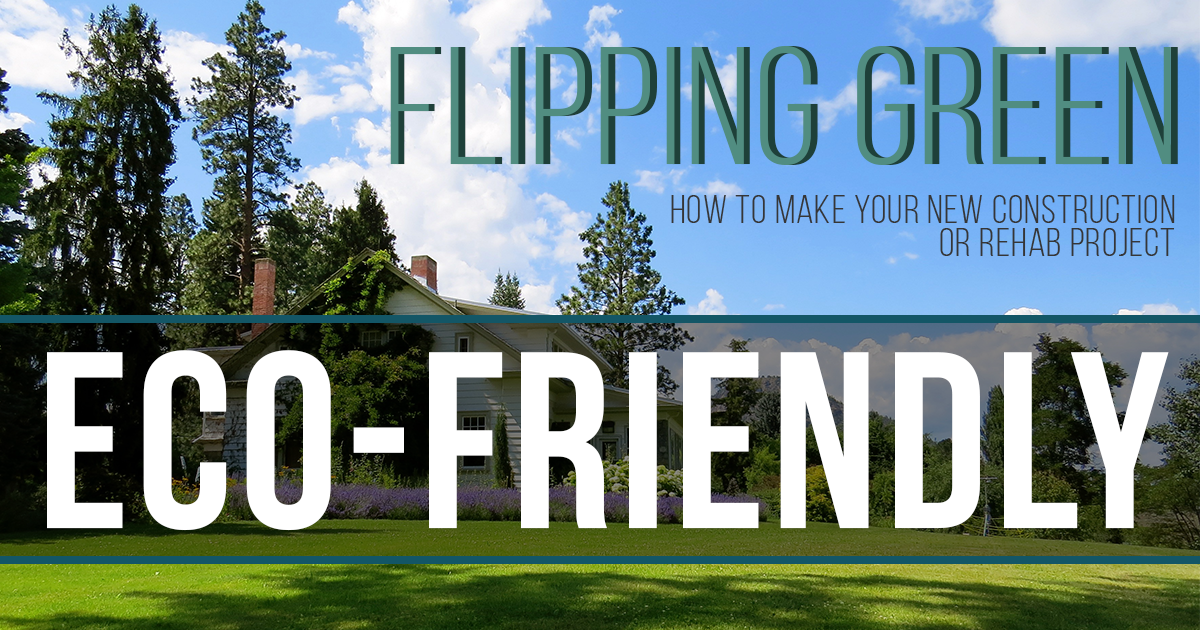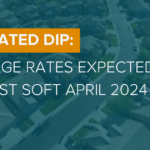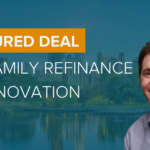Executive Summary
Eco-friendly updates to fix and flip or new construction projects are not only an ethical decision but also a financially sound one. This paper will explore alternative construction choices that will move you into the future, increase your sale price, and make you feel good at the same time. There are many different ways to incorporate environmentally friendly options into your project, from the building materials you use to the design of the bathroom to the type of lighting you install.
Some alternate insulation options include sheep’s wool, cotton, and Aerogel while you can choose to build with straw bales or rammed earth instead of concrete. Additionally, by changing the way you build roofs, decks, and driveways, you can add thousands of dollars in value to your home and help future homeowners save on their utility bills. The paper will also explore healthy and sustainable flooring and countertop options as well as more efficient methods of heating and cooling a home.
Finally, the paper will summarize the requirements for ENERGY STAR and LEED home certifications: both of which will increase the selling price of your home and reduce its time on the market.
[toc]
[su_row][su_column]
Introduction
Americans are no longer living in the 1950s, when scientists, producers, and consumers alike were ignorant of the negative environmental impact of cheap, mass-produced goods like plastics, PVCs, and lead-based lighting. Now, we know about the dangers of building without considering the environmental impact of our materials. We are also aware of the many benefits of eco-friendly residential construction, including higher sale prices, positive publicity, and tax credits. For the investor who makes green updates a priority, there can be huge ethical and financial rewards.
A Realtor.com survey showed that most homeowners take the environmental impact of their property into consideration, with over 30% of respondents saying they live in an eco-friendly home and almost 85% saying that they would like to in the future. The respondents who do not currently live in eco-friendly homes still take steps to reduce their carbon footprint: 80% use energy-efficient appliances and 75% maintain energy-efficient lighting. Efficient appliances and lights are so widespread now that their long-term cost effectiveness is indisputable.
It is clear that energy efficient home features are desirable to homebuyers; 86% of respondents wanted efficient air conditioning, 85% wanted efficient appliances, and 79% wanted efficient lighting. The desire for environmentally conscious homes can translate to big bucks in a smart investor’s pocket.[/su_column][su_column]
A California study showed that a house with a green certification label sells for 9% more than similar, non-green alternatives (Washington Post). Of course, this is just an average: if you are upgrading a home in an area where the residents support energy conservation, you are going to get better returns. To measure this, you can use the same tactic as the researchers: look at the percentage of hybrid-auto registrations in the area.
So how does an environmentally conscious investor score that coveted green certification label?
The two main labels for green homes are ENERGY STAR and LEED. The ENERGY STAR system is available for homes that reduce heating, cooling, and water usage costs as well as designs that improve indoor air quality. LEED certifications, on the other hand, focus more on projects that practice sustainable building. This paper will explore alternatives that will help you work toward earning each of these certifications so you can choose the renovations most suited to your purposes.
Green buildings reduce energy use by 30%-50%, reduce CO2 emissions by 35%, reduce waste output by 70%, and reduce water usage by 40%. Since they typically cost around 3%-5% more than conventional buildings and sell for 9% extra, building green in forward-thinking locales is an easy and profitable choice to make (Ableskills).[/su_column][/su_row]
Green Construction Materials
Whether you are building a new home or adding to an existing one, you can make sustainable and environmentally friendly construction choices without breaking the bank. There are lots of alternatives to conventional materials with different pros and cons to each. Here is a breakdown of some of your options.[su_row][su_column]
Sheep Wool
Material Cost: $1.85 per sq. ft. (Fiberglass cost: $0.30 per sq. ft.)
Sheep wool is becoming a popular, eco-friendly alternative to traditional insulation materials like fiberglass or foam board. It is a direct replacement for other insulators and can be installed into a conventionally constructed home. It works by trapping air in tiny air pockets, which is why it keeps sheep warm in the winter and cool in the summer and why it will do the same for your home (HowStuffWorks).
Pros: Sheep wool is a sustainable choice to insulate a home and is a strong insulator with an R value comparable to fiberglass – however, it retains its R value for around 50 years compared to 10 years for fiberglass. It is breathable, fire-resistant, and mold-resistant. It also traps pollutants like CO2 and is safe to handle without protective gear. Additionally, it absorbs water without feeling damp and generates heat to prevent condensation (Eco Building Products).
Cons: It is more expensive than fiberglass and similar in price to high-end insulation types like spray foam. Additionally, it must be treated with boric acid or it may be damaged by moths.
Cotton
Material Cost: $0.90 per sq. ft. (Fiberglass cost: $0.30 per sq. ft.)
Since there are so many companies that produce cheaper textiles for clothing, there is a lot of recycled cotton available for house insulation. It has an R value just as high or higher than most fiberglass and wool.
Pros: Cheaper than wool, this material is still flame-retardant when treated with boron. It comes from a natural source and requires little energy to produce. Additionally, it is a deterrent to certain insects (Planning Tiny).
Cons: Cotton is a water heavy crop that most farmers use pesticides to grow.
Aerogel
Material Cost: $2.00 per board ft. (Fiberglass cost: $0.30 per sq. ft.)
Until recently, Aerogel was so expensive that only NASA could afford it. They are produced by taking the liquid out of gels and are over 90% air. Because they are so porous and lightweight, they are extremely powerful insulators, with an R value many times higher than fiberglass (Cnet).
Pros: Since they are so powerful, homeowners will reduce their energy use for heating and cooling drastically in a home insulated by Aerogel. Additionally, since the product is 90% air, there are no extra chemicals or offgassing. It can also be used between transparent panels since it is translucent.
Cons: This is the most expensive insulation available. It is not produced as cleanly as wool or cotton, being derived from petrochemicals, and is known for being very dusty.[/su_column][su_column]
Straw Bale
Building Cost: $110-$170 per sq. ft. (Conventional: $125 per sq. ft.)
Typically, building a straw bale home will cost about 10% more than a conventional construction project (StrawBale.com). Even though the material itself is very cheap, the labor required for a straw bale home is extensive: you need to stack, shape, prep, and plaster the walls. If your project is small and you plan on doing the work yourself, using straw bales will actually save you money. One group was able to build a straw bale home for only $32 per square foot since they did most of the work themselves and gravitated toward recycled materials (Solar Haven). The work is simple but labor intensive, so if you are doing it yourself be prepared to expend a lot of effort and if you are hiring a contractor make sure they are experienced and excited about building environmentally friendly homes.
Pros: Straw bale is also an incredible insulator tand will save future homeowners on heating and cooling costs. Because it is packed so tightly, it is also fire resistant. In addition, the material is an agricultural by-product and an annually-renewable resource. It allows for construction without an enormous carbon-footprint (Paja Construction).
Cons: There are some areas of the country that do not allow straw bale construction, so check and see if it’s an acceptable practice in your location prior to deciding on this method. In addition, if the construction is not properly done, they are more susceptible to insect infestations and mold than typical materials (another reason to go with an experienced contractor).
Rammed Earth
Building Cost: $110-$160 per sq. ft. (Conventional: $125 per sq. ft.)
Rammed earth is a mixture of dirt, gravel, sand, silt, and clay that is poured between flat panels, then compressed. It is strong enough to stand alone as a loadbearing construction, but can also be fortified with reinforcements, similar to concrete (YourHome). Although this is a new technique for modern building, it has been used since ancient times.
Pros: Although it is not an insulator, rammed earth has a lot of thermal mass which will slow the transfer of heat. In addition, it is durable, moisture-, vermin-, and fire-resistant, and breathable. Rammed earth is also a natural product and its manufacturing has little negative environmental impact.
Cons: Installing rammed earth walls is labor-intensive and the shape is limited: you cannot build rounded walls or have much structural variation. Additionally, colder climates require additional insulation which reduces the breathability of the structure (Alternative Housing).[/su_column][/su_row]
Exterior Alternatives
[su_row][su_column]
Roof
Here is a summary of common roof pricing from Angie’s List.
Another option is to put solar panels on angled roofs. You can use resources like the Solar Electricity Handbook to determine the optimally efficient angle in your location. However, unless you are building in an extremely wealthy and environmentally conscious region, this many not be the best investment for a rehab or new construction project. Instead, build new roofs at the optimal angle and inform potential buyers that they can install solar panels with maximum efficiency.[/su_column][su_column]
Driveway
A simple, eco-friendly alternative to a traditional asphalt driveway is to install grasscrete, a concrete-grass paving system that can range from $3-$10 per square foot (Improvenet). If you already need to replace or add a driveway, this is an easy and affordable alternative to asphalt, which normally costs around $4/sq ft.
To install this green driveway, you lay down a base of large crushed stones on top of the existing soil, add a bedding of crushed gravel or brick on top, place the open-center pavers, then fill them with soil or turf. You can opt for materials other than concrete, like stone or recycled plastic, but concrete is typically regarded as the best combination of affordability and visual appeal.
Deck or Patio
If you feel that a deck is necessary for your real estate project, you are going to have to choose between the lesser of two evils.
While wood decks are a natural, healthy, and biodegradable option, it is difficult to tell if the wood was harvested using sustainable methods – and if it was, it is likely expensive. Additionally, natural decks are high maintenance and the stains and seals required to make them durable are toxic to the environment.
Composite decks, on the other hand, are often manufactured using recycled materials and are very durable and low maintenance – they can be cleaned with only soap and water. There are different options available, but they are all a combination of organic materials and synthetic. As a result, they are neither compostable nor recyclable, meaning that when they do eventually need to be replaced there is no green way to dispose of them (Treehugger).
If possible, consider installing a patio instead. You can choose from a wide variety of eco-friendly pavers made from stone, bamboo, or cork. You can even choose concrete and apply a non-toxic soy stain to make it more visually appealing. This way, you avoid the deck dilemma and create a natural space that works with its surroundings.
Indoor Eco Updates
[su_row][su_column]
Appliances
The first step you should take in any environmentally friendly home is replacing old and clunky appliances with ENERGY STAR rated models. Although they are more expensive than other, less efficient models, they are obvious long-term money savers for smart homebuyers. Most homeowners already have some of these appliances and potential buyers will expect them. The question isn’t should you choose ENERGY STAR appliances, but which ENERGY STAR appliances should you choose? Once again, base your decisions on the income level and environmental mindset of the area.[/su_column][su_column]
Flooring
There are lots of different options for flooring with varying costs and environmental impacts. Three environmentally friendly options include bamboo or cork for between $4-$12 per sq. ft. and repurposed hardwood for $3-$8 per sq. ft.
For tiles, choose linoleum instead of vinyl. Vinyl is produced with a number of carcinogens, chemicals, and other toxins and is one of the worst floorings to choose, from an environmental impact perspective.[/su_column][/su_row]
Here is a summary of common flooring options and their costs (pricing per square foot):
*DATA FROM HOME FLOORING PROS/ZILLOW
| Hardwood | Cork & Bamboo | Laminate | Carpet | Vinyl | Tile |
| $3-$8 | $4-$12 | $1-$6 | $2-$26 | $1-$8 | $4-$8 |
| DIY: Difficult | DIY: Medium | DIY: Easy | DIY: Medium | DIY: Easy | DIY: Medium |
[su_row][su_column]
Building a Green Kitchen
There are three key green alternatives to standard countertop materials: paper-based, bamboo, and recycled glass.
Paper-Based
Cost: starting at $30 per sq. ft.
These are a simple, cheap, and low maintenance choice. However, the color choices are limited, as paper-based countertops are only available in dark, matte hues. In addition, while surface scratches can be fixed, discoloration is almost guaranteed with long-term use (Remodelista).
Bamboo
Cost: starting at $40 per sq. ft.
Although these countertops are durable and extremely environmentally friendly, they are high-maintenance and easily stained. However, there are a lot more color, finish, and grain options than there are for paper-based countertops (Improvenet).
Recycled Glass
Cost: starting at $50 per sq. ft.
This is the high-end eco-friendly option with a price similar to slab granite. It is beautiful and very tough, so it will last a long time without discoloration or staining (Improvenet). There is an incredibly wide selection of styles to choose from, from countertops replicating granite to brightly colored or translucent options.
Building a Green Bathroom
Here, the most important environmental factor to consider is water waste. To temper water usage (and save money on water bills), investors can install low-flow toilets, showerheads, and faucets.[/su_column][su_column]
Choose tiles made of recycled content for the floor and put in lots of carefully-placed windows to naturally improve ventilation and add light (Treehugger).
Heating, Cooling, and Lighting
Here, investors really have an opportunity to create an energy-efficient and environmentally friendly house. There are lots of easy and inexpensive updates that will allow you to advertise your project as a green home.
One slightly unconventional air conditioning alternative is a whole-house fan in the attic. It costs around $150-$550, although keep in mind that the installation costs will tack on an additional $1,000. In addition, you may need to add additional roof vents to the attic so it can handle the large volume of airflow.
It works by pulling in cool air at night and circulating it throughout the house during the day. Even in hot weather, it can serve as a replacement for air conditioning and keep families comfortable, and it only uses 10% of the energy of an air conditioner. One downside is that it can be noisy: take steps to mitigate this issue by installing rubber or felt gaskets (Energy.gov).
However, buyers may be wary of a house without air conditioning, especially in warmer climates. You can supplement the whole-house fan with a low-powered central unit, starting at $500, or with smaller units in key areas such as bedrooms.
If the whole house fan is not right for your project, you can choose an ENERGY STAR HVAC system to cut cooling costs by as much as 30%.
As far as lighting is concerned, you should install LED bulbs instead of fluorescent or incandescent lights. Not only are they longer-lasting and more energy efficient, but they are cheaper in the long run as well.[/su_column][/su_row]
| Source: Simple Dollar | Incandescent | CFL | LED |
| Approximate cost per bulb | $1 | $2 | $8 |
| Average lifespan | 1,200 hours | 8,000 hours | 25,000 hours |
| Watts used | 60W | 14W | 10W |
| No. of bulbs needed for 25,000 hours of use | 21 | 3 | 1 |
| Total purchase price of bulbs over 23 years | $21 | $6 | $8 |
| Total cost of electricity used (25,000 hours at $0.12 per kWh) | $180 | $42 | $30 |
| Total operational cost over 23 years | $201 | $48 | $38 |
Outdoors, you can install solar-powered garden lights that will charge during the day and turn on at night. These are so popular nowadays that you can choose from a wide variety of styles without increasing your budget at all.
Obtaining a Green Building Certification
ENERGY STAR
If your goal is to build an energy efficient home (and help the future homeowners keep their utility bills low), then you are going to want to apply for the ENERGY STAR label. To gain the ENERGY STAR certification, you need to meet certain minimum efficiency requirements. Here is a general outline of the standards.
Mandatory Requirements (data from ENERGY STAR Version 3 Requirements):
| Party Responsible | Mandatory Requirements |
| Rater |
|
| HVAC System Designer |
|
| HVAC Installing Contractor |
|
| Builder |
|
ENERGY STAR Reference Design Home (data from ENERGY STAR Version 3 Requirements):
| Hot Climates | Mixed and Cold Climates | ||
| Cooling Equipment |
|
|
|
| Heating Equipment |
|
|
|
| Envelope, Windows, and Doors |
|
|
|
| Water Heater |
|
|
|
| Thermostat and Ductwork |
|
|
|
| Lighting and Appliances |
|
|
| Benchmark Home: | |||||||||
| Bedrooms to be Built | 0 | 1 | 2 | 3 | 4 | 5 | 6 | 7 | 8 |
| Conditioned Floor Area | 1,000 | 1,000 | 1,600 | 2,200 | 2,800 | 3,400 | 4,000 | 4,600 | 5,200 |
Find out more about qualifying for an ENERGY STAR certification here.
LEED
If you are focusing on building with environmentally conscious practices and sustainable materials, then you want to make sure you earn a LEED label. Unlike the ENERGY STAR program, the LEED system works by awarding points for different sustainable building factors.
Here are the minimum program requirements for LEED (From USGBC.org):
- Must be in a permanent location on existing land.
- Must use reasonable LEED boundaries.
- Must comply with project size requirements.
Check out this site for more information on the minimum LEED requirements.
To be LEED certified, your house needs to earn at least 40 points, but the more points you earn the higher the reward. Here are the requirements for each level of LEED:
| Level | Points |
| Certified | 40-49 |
| Silver | 50-59 |
| Gold | 60-79 |
| Platinum | 80+ |
Here is an outline of all the prerequisites and credits for which you can earn points toward a LEED certification (from USGBC.org):
[su_spoiler title=”CLICK TO EXPAND CHART” icon=”plus-circle”]
| Credit/Prerequisite Name | Points Available |
| Integrative Process (C) | 2 |
| Location and Transportation: | |
| Floodplain Avoidance (P) | Required |
| LEED for Neighborhood Development (C) | 15 |
| Site Selection (C) | 8 |
| Compact Development (C) | 3 |
| Community Resources (C) | 2 |
| Access to Transit (C) | 2 |
| Sustainable Sites: | |
| Construction Activity Pollution Prevention, No Invasive Plants (P) | Required |
| Heat Island Reduction (C) | 2 |
| Rainwater Management (C) | 3 |
| Non-Toxic Pest Control (C) | 2 |
| Water Efficiency: | |
| Water Metering (P) | Required |
| Total Water Use (C) | 12 |
| Indoor Water Use (C) | 6 |
| Outdoor Water Use (C) | 4 |
| Energy and Atmosphere: | |
| Minimum Energy Performance, Energy Metering, Education of the Homeowner, Tenant, or Building Manager, Home Size (P) | Required |
| Annual Energy Use (C) | 29 |
| Efficient Hot Water Distribution System (C) | 5 |
| Advanced Utility Tracking (C) | 2 |
| Active Solar-Ready Design (C) | 1 |
| HVAC Start-Up Credentialing (C) | 1 |
| Building Orientation for Passive Solar (C) | 3 |
| Air Infiltration (C) | 2 |
| Envelope Insulation (C) | 2 |
| Windows (C) | 3 |
| Space Heating and Cooling Equipment (C) | 4 |
| Heating and Cooling Distribution Systems (C) | 3 |
| Efficient Domestic Hot Water Equipment (C) | 3 |
| Lighting (C) | 2 |
| High-Efficiency Appliances | 2 |
| Renewable Energy (C) | 4 |
| Materials and Resources: | |
| Certified Tropical Wood, Durability Mangement (P) | Required |
| Durability Management Verification (C) | 1 |
| Environmentally Preferable Products (C) | 4 |
| Construction Waste Management (C) | 3 |
| Material-Efficient Framing (C) | 2 |
| Indoor Environmental Quality: | |
| Ventilation, Combustion Venting, Garage Pollutant Protection, Radon-Resistant Construction, Air Filtering< Environmental Tobacco Smoke, Compartmentalization (P) | Required |
| Enhanced Ventilation (C) | 3 |
| Contaminant Control (C) | 2 |
| Balancing of Heating and Cooling Distribution Systems (C) | 3 |
| Enhanced Compartmentalization (C) | 1 |
| Enhanced Garage Pollutant Protection (C) | 2 |
| Low-Emitting Products (C) | 3 |
| Innovation: | |
| Preliminary Rating (P) | Required |
| Innovation (C) | 5 |
| LEED AP for Homes (C) | 1 |
| Regional Priority (C) | 4 |
[/su_spoiler]Check out this guide for more information on what you need to do to qualify for a LEED certification: https://www.usgbc.org/cert-guide/homes
Selling Your Green Home
[su_row][su_column]According to USGBC.org, by 2018, 84% of all residential construction will include sustainable features and green single-family housing will represent 40% of the market. In addition, the residential green construction market is expected to grow by 24.5% a year. For investors who are ahead of the curve, this growth can translate to major profits and fast-moving houses.
To convince homebuyers that your completed home is worth the extra money, remind them that the house provides:
- Sustainability
- Appeal to the potential buyer’s ethics by informing them that the house was build with a minimal footprint and that the efficient design will help them lessen their environmental impact.
- Financial Savings
- The many energy- and water-saving features you incorporate will translate to major savings on utility bills for the owners. Make sure you take the time to calculate exactly how much consumers can save by looking at the ratings of all of your appliances and researching the average savings of the other features you included. That way, you can convince buyers of the financial benefits with hard data.[/su_column][su_column]
- Healthy Living
- Since you used healthy materials without toxic chemicals, your home will have great indoor air quality and will allow the homeowners to live cleanly. Plus, there is evidence that green building materials can actually reduce the severity of asthma symptoms and allergies.
- High Resale Value
- If an eco-friendly house is a financial benefit for you and the potential buyers, then it will be a plus when they eventually sell. The world is moving toward green living and sustainability, so the profit in selling a green home will only increase with time.
By pointing out the many benefits of green living to homebuyers, you will make the most out of all of the work and money you put into your environmentally friendly fix and flip or new construction project (BoomTown).[/su_column][/su_row]
Conclusion
There are some general guidelines that you can follow to build a better home, such as choosing paints without volatile organic compounds, or VOCs. In addition, add windows and skylight to reduce the need for electric light and open up the space. Whenever possible, choose recycled materials for your construction and buy from companies that harvest or manufacture sustainable goods.
Working toward environmentally conscious real estate investments has numerous ethical and financial benefits that a smart investor can enjoy by implementing the eco-friendly upgrades suggested here. However, remember that you are an investor first and a good samaritan second, so don’t overspend trying to build an ultra-efficient home unless you are certain it will pay off.
The most important aspect of an environmentally-friendly real estate investment project is that you choose the best options available within your price range every step of the way. Going in, select an architect and contractor that are known for their green values and past environmentally-friendly work. They will be able to help you design an energy-efficient home and build it sustainably. Follow ENERGY STAR and Leed guidelines and you will end up with a home that any educated and environmentally-conscious individual will be proud to call their own.
[su_note note_color=”#fefefe” text_color=”#4b4b4b” radius=”0″]

Download This Whitepaper As A PDF
Flipping Green
How to Make Your New Construction or Rehab Project Eco-Friendly
Download The Free Whitepaper
[/su_note]
[su_spoiler title=”Sources” icon=”plus-circle”]
- https://www.realtor.com/news/real-estate-news/most-americans-want-eco-friendly-homes/
- https://www.washingtonpost.com/realestate/study-finds-that-energy-efficient-homes-often-command-higher-prices/2012/07/19/gJQAF4MiwW_story.html?utm_term=.b0f52fee7758
- https://www.constructionglobal.com/equipment-and-it/infographic-green-alternatives-conventional-building-materials
- https://www.asiagreenbuildings.com/14221/green-building-material/
- https://inhabitat.com/11-green-building-materials-that-are-way-better-than-concrete/
- https://home.howstuffworks.com/home-improvement/construction/green/5-green-insulation-options1.htm
- https://eco-buildingproducts.com/product/24-sheeproll-natural-wool-insulation-roll/?v=7516fd43adaa
- https://www.planningtiny.com/theas-side-by-side-insulation-comparison/
- https://www.cnet.com/news/high-tech-aerogels-wrap-homes-with-insulation/
- https://www.strawbale.com/cost-of-bale-construction/
- https://www.solarhaven.org/StrawBaleHouseBudget.htm
- https://pajaconstruction.com/advantages-and-challenges-of-straw-bale-construction/
- https://www.yourhome.gov.au/materials/rammed-earth
- https://sicarius.typepad.com/althouse/2009/03/rammed-earth-construction-pros-cons.html
- https://www.hgtv.com/design/real-estate/10-green-home-updates
- https://energy.gov/energysaver/energy-efficient-home-design/cool-roofs
- https://www.angieslist.com/articles/what-average-cost-replace-roof.htm
- https://www.poplarnetwork.com/topics/cool-roofs
- https://www.statefarm.com/simple-insights/smart-ideas/wondering-about-metal-roofs-here-are-the-pros-and-cons
- https://www.solarpaneltilt.com/
- https://www.improvenet.com/r/costs-and-prices/grass-pavers-estimator
- https://www.angieslist.com/articles/how-much-does-it-cost-install-asphalt-driveway.htm
- https://www.treehugger.com/green-architecture/deck-wood-or-plastic.html
- https://www.choicehomewarranty.com/blog/50-tips-for-an-energy-efficient-home/
- https://dealnews.com/features/How-Much-Money-Will-You-Save-With-Energy-Star-Appliances/558643.html
- https://www.zillow.com/blog/types-of-flooring-and-their-costs-58880/
- https://www.thespruce.com/environmental-impact-of-vinyl-flooring-1314956
- https://www.build.com.au/design-energy-efficient-kitchen
- https://www.houselogic.com/by-room/kitchen/green-kitchen-countertops-3-eco-friendly-choices/
- https://www.remodelista.com/posts/remodeling-101-paper-composite-countertops-pros-and-cons/
- https://www.improvenet.com/r/costs-and-prices/bamboo-countertops
- https://www.treehugger.com/htgg/how-to-go-green-bathroom-renovation.html
- https://energy.gov/energysaver/cooling-whole-house-fan
- https://www.thesimpledollar.com/the-light-bulb-showdown-leds-vs-cfls-vs-incandescent-bulbs-whats-the-best-deal-now-and-in-the-future/
- https://www.energystar.gov/ia/partners/bldrs_lenders_raters/downloads/ES%20NPR%20v84%202015-12-09_clean_508.pdf?d035-c7d9
- https://www.usgbc.org/articles/whats-difference-between-leed-credit-leed-prerequisite-and-leed-point
- https://www.usgbc.org/articles/leed-homes-credits-and-points
- https://www.usgbc.org/articles/benefits-green-homebuilding
- https://boomtownroi.com/blog/moving-a-green-home-heres-how-to-sell-it/ [/su_spoiler]







0 Comments